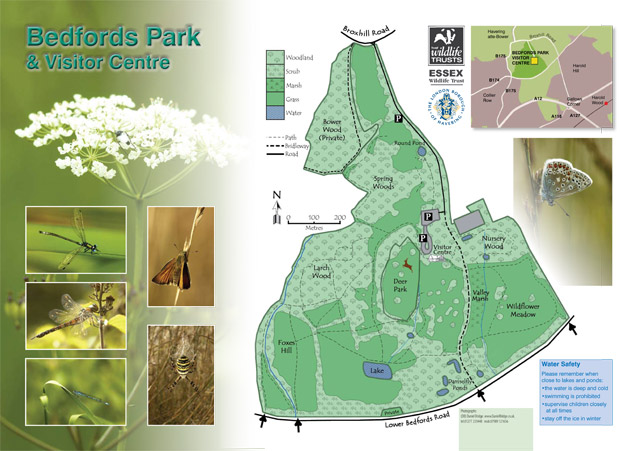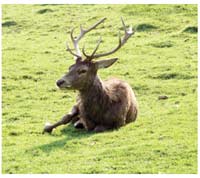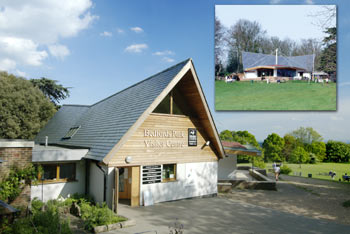Bedfords Park and Visitor Centre - Healthy Life Essex
Home » Articles » Outdoor Life » Countryside in Essex » Country Parks & Nature Reserves » With Visitor Centres » Bedfords Park and Visitor Centre
A 215 acre haven for people and wildlife,
Just 3 miles north of the hustle and bustle of Romford.
Nestling between Havering-atte-Bower and Harold Hill, the park was once a private estate with an impressive manor house, but is now home to an Essex Wildlife Trust Visitor Centre. Although it is not a nature reserve, the flora and fauna here has a surprising diversity and abundance, and Bedfords could give many a reserve a good run for its money!
The park consists of various habitats on a south-facing slope overlooking the Thames basin, with far reaching views from the Queen Elizabeth II Bridge, panning across Canary Wharf and the Dome right up to the centre of London, with the north downs of Kent in between. Areas of woodland, scrub, meadows, ponds and a lake ensure a broad range of interest for birds, mammals and invertebrates alike, as well as the human visitors that come here to walk and relax.

Open a larger scale copy of this map in Adobe pdf format![]()
History of Bedfords Park and Visitor centre
Bedfords Park has a long history. This area was first mentioned back in 1212, when King John took the land from John Derewin as forfeiture for homicide, and gave it to William D’Aubigny for the  annual rent of one Sparrowhawk! Over the next few centuries the land passed between various owners and became part of the Gidea Hall Estate, belonging to Sir Thomas Cooke, Lord Mayor of London. In the late 1700’s, John Heaton bought Bedfords and built the manor house, and it was from then on that the park developed its current character, especially during the period when Charles Barber planted many specimen trees. Many of these still stand, and include Monkey Puzzle, Wellingtonia and Cedar of Lebanon.
annual rent of one Sparrowhawk! Over the next few centuries the land passed between various owners and became part of the Gidea Hall Estate, belonging to Sir Thomas Cooke, Lord Mayor of London. In the late 1700’s, John Heaton bought Bedfords and built the manor house, and it was from then on that the park developed its current character, especially during the period when Charles Barber planted many specimen trees. Many of these still stand, and include Monkey Puzzle, Wellingtonia and Cedar of Lebanon.
In 1932 the Park was sold to Romford Council (now the London Borough of Havering), and it was opened as a public park in 1934. A captive herd of Red Deer were then introduced, harking back to the days of the Royal Hunting Grounds. The manor house was used as a museum, but it unfortunately became derelict during the war, and was demolished in 1959. A café was built on the site and the Park was very popular throughout the 60s, 70s and 80s. Unfortunately, the café closed and Bedfords suffered a decline until Essex Wildlife Trust entered a partnership with Havering Council, and the Visitor Centre was opened in 2003. Today the park is back to its former glory, well used by families, with a full range of events and activities to keep everyone entertained.

FLORA AND FAUNA
With various habitats, it’s no surprise that there is a wealth of wildlife at Bedfords Park. Woodlands, including some ancient areas with bluebells, wood anemone and yellow archangel, support, nuthatch, tawny owl, various tits and all three species of woodpecker. Wild fallow, roe and muntjac deer wander through the Park, and foxes and weasels are regularly spotted.
The meadows have an abundance of butterflies and other invertebrates in the summer, the ‘Wildflower Meadow’, on the east side of the Park, being a particular highlight. This is an unimproved meadow, supporting many rare species of grasses and flowers, such as pepper saxifrage and pignut – probably the biggest populations of these in Essex. The long grasses harbour grasshoppers and crickets, which have in turn attracted the stunning yellow and black wasp spider. Look out for their webs amongst the grass – try to count them all (you may lose count at a thousand or so!).
The ponds and lake are undoubtedly some of the best places to see dragonflies and damselflies, with 16 species breeding here and 22 species seen since the Visitor Centre opened. Small red-eyed damselflies, in Britain since 1999, now breed in their thousands on the lake, and hairy dragonflies visit each year, which is unusual for an inland site like this. Most of the ponds are inhabited by great crested and smooth newts, and grass snakes are often seen nearby or swhimming across a pond in search of a meal.
 THE VISITOR CENTRE
THE VISITOR CENTRE
Built on the site of the manor house, and later café, the Visitor Centre incorporates many sustainable features to reinforce the environmental message that Essex Wildlife Trust conveys. Part of the structure of the café was reused; large double glazed windows help to absorb the warmth of the sun and a stonecrop roof retains water and aids insulation; four computers are available for you to find out information about wildlife, the Park and Essex Wildlife Trust; a sightings board records the birds and other animals spotted; and a history board charts a timeline through the life of the Park, from King John to the present day.
The gift shop has a wide range of toys and gifts for all ages, as well as bird foods and feeders, binoculars and telescopes. You can sit in the observation area, looking out over Romford and the River Thames, having a tea or coffee, eating a sandwich or just treating yourself to some chocolate. In the summer there is an observation beehive in the education room, where you can watch the honey bees coming and going, building up the honeycomb and doing their dances!
Just outside we have the ‘Morning Dew’ garden from the Chelsea Flower Show 2003, designed by Stephen Hall for Essex Wildlife Trust, winning a Silver Medal in the Courtyard Garden category. It offers a gazebo to sit under – listening to the burbling water feature and watching the birds coming to the nearby feeders.
Every June the Centre’s birthday is celebrated with live music, crafts, guided walks and children’s activities. There are also guided walks, Wildlife Discovery Days and Family Nature Days throughout the summer, publicised in the events leaflet available in the Centre, on the Essex Wildlife Trust website.and also on our Wildlife and Countryside Events section on this web site.
EDUCATION
The Centre has two education team members – an Education Officer who runs the children’s activities and school visits in the Centre, and a Community Wildlife Officer who provides outreach work in Havering, at schools, youth groups and churches. A dedicated room for these activities is available, with a stunning wildlife mural along one wall, painted by local artist Paul Young.
Birthday parties are a favourite for children, these being wildlife themed, with pond dipping, minibeast hunting or meadow sweeping, depending on the time of year, as well as a visit to the Red Deer to give them some carrots!
VISITOR CENTRE FACILITIES
The Visitor Centre has access for wheelchairs and male and female disabled toilets. Disabled access to the Park is limited as the site is on a slope, with paths through woodland being especially problematic. Disabled parking is available in the Trust’s woodland car park, from where a sloping path leads down to the Centre.
Dogs (except Guide Dogs) are not allowed in the Visitor Centre, but can be taken anywhere in the Park. Horse riding is allowed along the bridleway only, which runs from north to south through the centre of the Park.
Location, opening Times and contact details:
 How to find us:
How to find us:
BY ROAD: Bedfords Park is 3 miles north of Romford, between Havering-atte-Bower and Harold Hill. From the Gallows Corner roundabout (A12/A127 junction), take ‘Straight Road’, signposted to Havering-atte-Bower. Turn right at the traffic lights at the end of Straight Road, then left into ‘Broxhill Road’. The entrance to the Park is on the left opposite the white water tower. Brown tourist signs point the way from various junctions in the area.
Opening Times:
Tuesday to Sunday: 9am – 5pm
Bank Holidays: 9am – 5pm
Closed: Mondays, Christmas Day & Boxing Day

For further information:
Bedfords Park Visitor Centre, Broxhill Road, Havering-atte-Bower, Romford, RM4 1QH
Telephone: 01708 748646 Fax: 01708 747254
Email: bedfords@essexwt.org.uk Website: www.essexwt.org.uk
Pictures by Daniel Bridge and Mike Wilson

